www.fumedesigns.com - Fume product range
Download as ppt, pdf0 likes240 views
The document lists various styling codes for fonts and formatting. It includes specific styles categorized by types such as 'fw', 'fh', 'fe', and 'fn'. Each category has associated numeric codes for identification.
1 of 24
Download to read offline
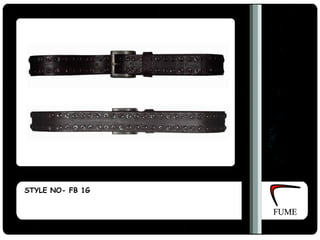
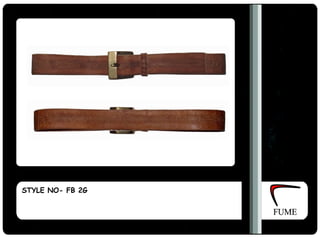
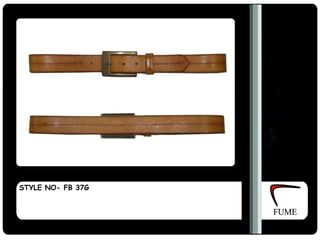
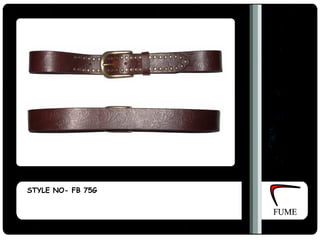
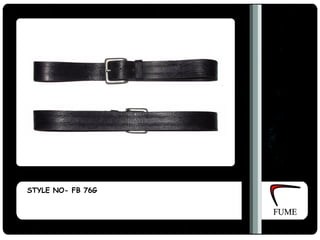
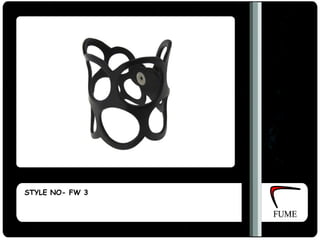

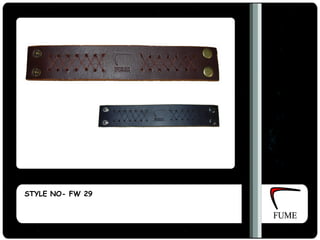
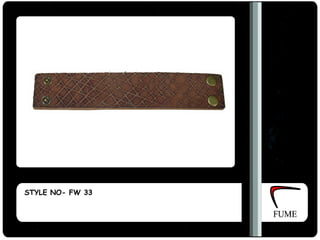

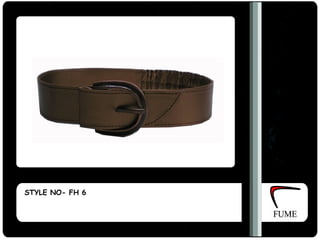
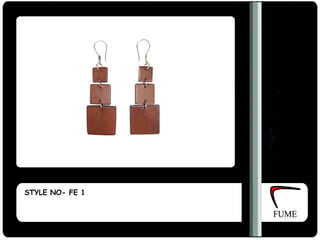
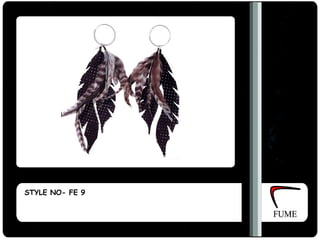

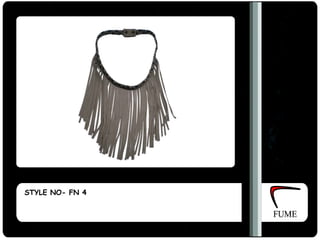
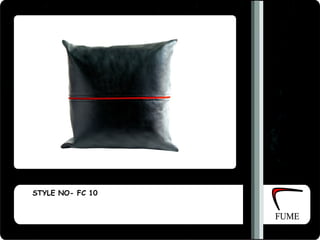

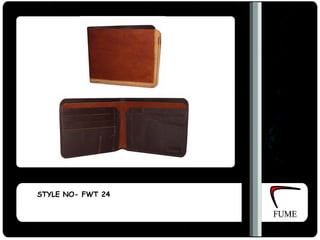

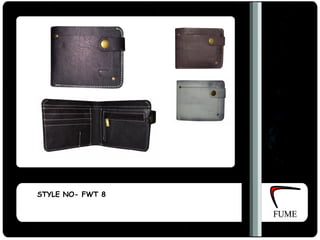
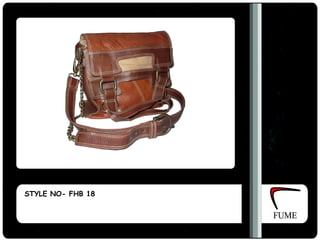

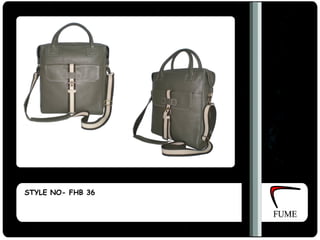
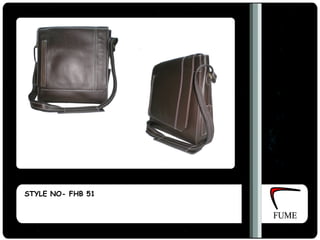
Ad
Recommended
Fume accessories
Fume accessoriesfumedesigns
?
This document lists various style numbers for different product lines. It includes style numbers for FW (women's), FH (women's), and FN (men's) lines ranging from 5 to 37, as well as FE (women's) style numbers 5 and 10.A4.0 ELEVATIONS
A4.0 ELEVATIONSMeinrado Sawal
?
This document provides material and color specifications for various building elements. It lists several fiber cement boards from James Hardie in colors like iron gray, arctic white, and cobble stone. It also specifies cementitious stucco and metal siding in a variety of colors selected from different manufacturers. Notes indicate some elements will be primed, painted or powder coated.12777 coastal single pages part69
12777 coastal single pages part69Coastal Joinery Hardware
?
This document provides information on different types of classic door hardware including Uno levers on backplates and roses, Victorian mortice knobs and rim knobs, and Classic Victorian Scroll levers. It lists various part numbers, descriptions, and available finishes for each type of hardware. Technical drawings are also included showing measurements for some of the hardware parts.Arco Products Pp
Arco Products PpAsad Rahman
?
This document contains a list of style numbers for various clothing items including blouses, dresses, pants, and tunics. The styles reference designs for single or double layered blouses, dresses, skirts, and pants in different fabrics and sizes.12777 coastal single pages part147
12777 coastal single pages part147Coastal Joinery Hardware
?
This document lists hardware items used for gates and fences, including padbolts, ring gate latches, suffolk latches, and drop bolts. It provides the part number, description, and stainless steel finish for each item. All of the items listed are made from 316 grade stainless steel.Embellishment all tab - John Balch
Embellishment all tab - John Balchfiddlestar
?
This document contains musical notation for the folk song "Soldier's Joy" including the melody, variations on part A, variations on part B, and a chord melody arrangement. It provides the notes, rhythms, and instrumentation for multiple versions of this traditional folk tune.Cam & Groove Couplings - Hose Fittings Linecard
Cam & Groove Couplings - Hose Fittings LinecardJGB Enterprises, Inc.
?
The document provides information on various hose fittings and cam & groove couplings offered by JGB Enterprises, including specifications for couplers, adapters, and reducers in different sizes. It includes contact information for multiple JGB branches and emphasizes the availability of fittings in various materials and configurations. The document also contains a warning regarding cancer and reproductive harm, along with ISO certification details.12777 coastal single pages part11
12777 coastal single pages part11Coastal Joinery Hardware
?
This document lists various antique casement window hardware items including curly tail casement fasteners, stays, and night vent wedge fasteners. The items are available in bronze, black, or painted white finish and different sizes ranging from 8 to 12 inches. It provides part numbers, descriptions, finishes and notes that bronze items and items with an "S" designation require special order with longer lead times.Ceremonial uniform accessories
Ceremonial uniform accessoriesE-Land Group
?
Dress Cords, Laces, Whistle Cords, Chin Cords, Trimmings, Buttons, Ribbons, Braids, Fringes, Aiguillettes, Neck Ties, Cords, Belts, Leather Belts, Sword knots, Sword Belts, Sam Browne Belts, Hat Cords, Leather Belts, Holsters, Shoulder Boards, Epaulettes, Gargets, Collar tabs, Ranks & Cuffs, Chevrons , Cuff-titles, Arms Bands, Jackets, Sash, Hackles & Plumes, Command Sticks, Chin straps, Lanyards & Tassels. Gloves, Army & Pace Sticks, Apron Cords, Curtain Cords, Printed Flags, Flags, Pipe Banners, Pennants & Etc.Leather industry slides an expansion plan
Leather industry slides an expansion planTaimur Ahmad
?
The document outlines an international expansion plan for Hub Leather Pvt. Ltd., detailing its introduction, company background, and proposed entry into the UK market. It covers political and economic risks, market analysis, and the marketing strategy, highlighting the company's product range, pricing strategy, distribution methods, and promotional activities aimed at attracting youth in the UK. Hub Leather, established in 1983 in Karachi, aims to leverage its luxury brand presence to broaden its reach in international markets.Leather belt
Leather beltsmartersmarty
?
1. The document proposes a project to manufacture leather belts with an annual production capacity of 18,000 pieces.
2. It will require a total capital investment of Rs. 3,82,800 with fixed capital of Rs. 1,16,400 and working capital of Rs. 2,66,400.
3. The project expects annual net profits of Rs. 6,63,800 with a high return on investment of 173.4% and break-even point of 26%.41186744 study-of-indian-leather-industry-2003-version
41186744 study-of-indian-leather-industry-2003-versionAbdul Mannan
?
This document provides an overview of the Indian leather industry. It discusses the history and global context of the leather industry. Some key points:
1. India ranks 8th globally in leather production and the industry is a major exporter and employer.
2. The industry has transformed from exporting raw materials in the 1960s to value-added finished products today.
3. Government policy initiatives since the 1970s have supported this transformation. Liberalized trade policies since 1991 have further fueled growth.
4. The document covers the global livestock population, production and trade of hides/skins, leather and leather products. It also discusses environmental aspects of leather production. leather production Ethiopia
leather production Ethiopiaabdulmenan sherif
?
This document discusses plans to establish Nature Leather International, a leather producing company in Ethiopia. The objectives are to create an internationally competitive brand in the Ethiopian leather market and show opportunities for investment. Nature Leather will produce leather garments, bags, shoes and other goods for the Ethiopian market as well as export to Turkey and other countries. Ethiopia is well-suited due to its large livestock population and potential for raw materials. Marketing strategies will include promotions tailored to each target market and using methods like social media, websites, and buyer visits appropriate to the culture.Indian leather industry
Indian leather industryShivansh Kottary
?
The Indian leather industry has grown significantly over the past decades to become a major foreign exchange earner and employer. Exports have increased from $320 million in 1965-66 to $69.5 billion in 1996-97. The industry has transformed from exporting raw materials to value-added finished products. It employs around 2 million workers across sectors like tanning, footwear, and leather goods. Major production centers are located in cities across India like Chennai, Kanpur, Delhi and Kolkata.Market research on accessories in india
Market research on accessories in indiaJaskirat Singh
?
This document provides a market research report on the fashion accessories industry in India commissioned by the Italian Trade Commission. It analyzes the market characteristics, consumer behavior, production, trade, competition and opportunities for Italian companies. The objectives are to identify potential buyers and forms of cooperation for Italian fashion products, examine regulations, and check competition and consumer needs in India. The research covers various aspects of the accessories sector in India including market size, demand drivers, price segments, regional consumer characteristics, preferred brands, production, imports, exports, competitors and distribution channels.Leather Tanning
Leather Tanningsblack0206
?
Leather tanning is the process of treating raw animal hides to prevent decay and make them suitable for use. It involves soaking, hair removal, pickling, and tanning the hides through either the more common chrome tanning process or vegetable tanning. Chrome tanning uses chemicals containing trivalent chrome to tan the hides over 8 hours, while vegetable tanning uses tannic acid extracted from tree bark over 2-4 days. After tanning, the hides undergo further processing like dyeing, rolling, and finishing to produce leather. Tanning can cause environmental impacts through air and water pollution from chemicals used. Methods to reduce impacts include reusing water, recovering chrome, using more efficient processes, and choosing vegetable tanningGive Your Salon a Gorgeous Makeover with Interior Designs That Reflect Your P...
Give Your Salon a Gorgeous Makeover with Interior Designs That Reflect Your P...SPL Interiors
?
Your salon is more than just a business it's a reflection of your creativity, energy, and love for making others feel beautiful. At SPL Interiors, we understand that, and we pour our hearts into designing salon spaces that are as stunning as the services you offer. From elegant reception areas to calming treatment rooms, we carefully plan every detail to ensure your clients feel welcomed, pampered, and inspired the moment they step in. Let’s design a salon that feels like home for you and a dreamy escape for your clients.3D-IC Design Kits for Drop-in Chiplets MDK, ADK, TDK - 20250121_PreConH_Wong_...
3D-IC Design Kits for Drop-in Chiplets MDK, ADK, TDK - 20250121_PreConH_Wong_...huyth14
?
3D-IC Design Kits for Drop-in Chiplets MDK, ADK, TDK日本假毕业证九州情报大学录取通知书碍滨滨厂翱蹿蹿别谤怎么办
日本假毕业证九州情报大学录取通知书碍滨滨厂翱蹿蹿别谤怎么办taqyed
?
2025年极速办九州情报大学毕业证【q薇1954292140】学历认证流程九州情报大学毕业证日本本科成绩单制作【q薇1954292140】海外各大学Diploma版本,因为疫情学校推迟发放证书、证书原件丢失补办、没有正常毕业未能认证学历面临就业提供解决办法。当遭遇挂科、旷课导致无法修满学分,或者直接被学校退学,最后无法毕业拿不到毕业证。此时的你一定手足无措,因为留学一场,没有获得毕业证以及学历证明肯定是无法给自己和父母一个交代的。
【复刻九州情报大学成绩单信封,Buy Kyushu Institute of Information Sciences Transcripts】
购买日韩成绩单、英国大学成绩单、美国大学成绩单、澳洲大学成绩单、加拿大大学成绩单(q微1954292140)新加坡大学成绩单、新西兰大学成绩单、爱尔兰成绩单、西班牙成绩单、德国成绩单。成绩单的意义主要体现在证明学习能力、评估学术背景、展示综合素质、提高录取率,以及是作为留信认证申请材料的一部分。
九州情报大学成绩单能够体现您的的学习能力,包括九州情报大学课程成绩、专业能力、研究能力。(q微1954292140)具体来说,成绩报告单通常包含学生的学习技能与习惯、各科成绩以及老师评语等部分,因此,成绩单不仅是学生学术能力的证明,也是评估学生是否适合某个教育项目的重要依据!
我们承诺采用的是学校原版纸张(原版纸质、底色、纹路)我们工厂拥有全套进口原装设备,特殊工艺都是采用不同机器制作,仿真度基本可以达到100%,所有成品以及工艺效果都可提前给客户展示,不满意可以根据客户要求进行调整,直到满意为止!
【主营项目】
一.九州情报大学毕业证【q微1954292140】九州情报大学成绩单、留信认证、使馆认证、教育部认证、雅思托福成绩单、学生卡等!
二.真实使馆公证(即留学回国人员证明,不成功不收费)
三.真实教育部学历学位认证(教育部存档!教育部留服网站永久可查)
四.办理国外各大学文凭(一对一专业服务,可全程监控跟踪进度)How Smart Design Can Transform Your Restaurant’s Customer Experience
How Smart Design Can Transform Your Restaurant’s Customer ExperienceSprintCo
?
Poor design can silently hurt your restaurant’s customer experience and bottom line. From cluttered layouts that disrupt flow to inconsistent branding that weakens identity, these pitfalls can cost more than you think.
In our latest post, we’re sharing practical fixes to common design challenges—from optimizing kitchen layouts to creating seamless customer experiences.
Ready to elevate your space? Let’s build a restaurant that looks great and works even better!
#RestaurantDesign #FandBInteriors #DesignTips #RestaurantSuccess #SprintCo #EfficientSpaces #CustomerExperience #BrandIdentity #sonamantriDevelopment of a Reinforcement Learning-Based Optimization Model for Customer...
Development of a Reinforcement Learning-Based Optimization Model for Customer...ljo758
?
Development of a Reinforcement Learning-Based Optimization Model for Customer Order Scheduling with Missing OperationsBusiness of Handmade report 1 by 200 Million Artisan
Business of Handmade report 1 by 200 Million Artisanderpinafluttr
?
Business of Handmade report 1 by 200 Million ArtisanExploratory Experiences Built by Design (UXPA25)
Exploratory Experiences Built by Design (UXPA25)Design for Context
?
Discovery… it’s more than just finding a piece of information to complete a specific task. It’s more than just search… it is uncovering the unexpected, the “aha!” moment, or the deeper story behind a familiar subject. It is an experience – the user experience – within a digital space.
This presentation begins by looking at some design examples within the cultural heritage domain that are crafted to foster and encourage curiosity, leading to discovery. Examples draw on different subjects, particularly ones that blend content from different genres and countries. We will unpack design approaches that deliberately invite curiosity and “horizontal navigation” through different information paths. Then, we will look more closely at some techniques that UX designers can use to shape these experiences, such as how to leverage the user’s context of use, how to integrate cultural contexts, and how to gracefully find meaning in large scale data sets.Turbomachinery_Presentation.pptx....... introduction and basic
Turbomachinery_Presentation.pptx....... introduction and basicabhisheksabhigowda47
?
Turbocharger I think I will be in even if I think I will be in even if I think I will be in even if More Related Content
Viewers also liked (8)
Ceremonial uniform accessories
Ceremonial uniform accessoriesE-Land Group
?
Dress Cords, Laces, Whistle Cords, Chin Cords, Trimmings, Buttons, Ribbons, Braids, Fringes, Aiguillettes, Neck Ties, Cords, Belts, Leather Belts, Sword knots, Sword Belts, Sam Browne Belts, Hat Cords, Leather Belts, Holsters, Shoulder Boards, Epaulettes, Gargets, Collar tabs, Ranks & Cuffs, Chevrons , Cuff-titles, Arms Bands, Jackets, Sash, Hackles & Plumes, Command Sticks, Chin straps, Lanyards & Tassels. Gloves, Army & Pace Sticks, Apron Cords, Curtain Cords, Printed Flags, Flags, Pipe Banners, Pennants & Etc.Leather industry slides an expansion plan
Leather industry slides an expansion planTaimur Ahmad
?
The document outlines an international expansion plan for Hub Leather Pvt. Ltd., detailing its introduction, company background, and proposed entry into the UK market. It covers political and economic risks, market analysis, and the marketing strategy, highlighting the company's product range, pricing strategy, distribution methods, and promotional activities aimed at attracting youth in the UK. Hub Leather, established in 1983 in Karachi, aims to leverage its luxury brand presence to broaden its reach in international markets.Leather belt
Leather beltsmartersmarty
?
1. The document proposes a project to manufacture leather belts with an annual production capacity of 18,000 pieces.
2. It will require a total capital investment of Rs. 3,82,800 with fixed capital of Rs. 1,16,400 and working capital of Rs. 2,66,400.
3. The project expects annual net profits of Rs. 6,63,800 with a high return on investment of 173.4% and break-even point of 26%.41186744 study-of-indian-leather-industry-2003-version
41186744 study-of-indian-leather-industry-2003-versionAbdul Mannan
?
This document provides an overview of the Indian leather industry. It discusses the history and global context of the leather industry. Some key points:
1. India ranks 8th globally in leather production and the industry is a major exporter and employer.
2. The industry has transformed from exporting raw materials in the 1960s to value-added finished products today.
3. Government policy initiatives since the 1970s have supported this transformation. Liberalized trade policies since 1991 have further fueled growth.
4. The document covers the global livestock population, production and trade of hides/skins, leather and leather products. It also discusses environmental aspects of leather production. leather production Ethiopia
leather production Ethiopiaabdulmenan sherif
?
This document discusses plans to establish Nature Leather International, a leather producing company in Ethiopia. The objectives are to create an internationally competitive brand in the Ethiopian leather market and show opportunities for investment. Nature Leather will produce leather garments, bags, shoes and other goods for the Ethiopian market as well as export to Turkey and other countries. Ethiopia is well-suited due to its large livestock population and potential for raw materials. Marketing strategies will include promotions tailored to each target market and using methods like social media, websites, and buyer visits appropriate to the culture.Indian leather industry
Indian leather industryShivansh Kottary
?
The Indian leather industry has grown significantly over the past decades to become a major foreign exchange earner and employer. Exports have increased from $320 million in 1965-66 to $69.5 billion in 1996-97. The industry has transformed from exporting raw materials to value-added finished products. It employs around 2 million workers across sectors like tanning, footwear, and leather goods. Major production centers are located in cities across India like Chennai, Kanpur, Delhi and Kolkata.Market research on accessories in india
Market research on accessories in indiaJaskirat Singh
?
This document provides a market research report on the fashion accessories industry in India commissioned by the Italian Trade Commission. It analyzes the market characteristics, consumer behavior, production, trade, competition and opportunities for Italian companies. The objectives are to identify potential buyers and forms of cooperation for Italian fashion products, examine regulations, and check competition and consumer needs in India. The research covers various aspects of the accessories sector in India including market size, demand drivers, price segments, regional consumer characteristics, preferred brands, production, imports, exports, competitors and distribution channels.Leather Tanning
Leather Tanningsblack0206
?
Leather tanning is the process of treating raw animal hides to prevent decay and make them suitable for use. It involves soaking, hair removal, pickling, and tanning the hides through either the more common chrome tanning process or vegetable tanning. Chrome tanning uses chemicals containing trivalent chrome to tan the hides over 8 hours, while vegetable tanning uses tannic acid extracted from tree bark over 2-4 days. After tanning, the hides undergo further processing like dyeing, rolling, and finishing to produce leather. Tanning can cause environmental impacts through air and water pollution from chemicals used. Methods to reduce impacts include reusing water, recovering chrome, using more efficient processes, and choosing vegetable tanningRecently uploaded (20)
Give Your Salon a Gorgeous Makeover with Interior Designs That Reflect Your P...
Give Your Salon a Gorgeous Makeover with Interior Designs That Reflect Your P...SPL Interiors
?
Your salon is more than just a business it's a reflection of your creativity, energy, and love for making others feel beautiful. At SPL Interiors, we understand that, and we pour our hearts into designing salon spaces that are as stunning as the services you offer. From elegant reception areas to calming treatment rooms, we carefully plan every detail to ensure your clients feel welcomed, pampered, and inspired the moment they step in. Let’s design a salon that feels like home for you and a dreamy escape for your clients.3D-IC Design Kits for Drop-in Chiplets MDK, ADK, TDK - 20250121_PreConH_Wong_...
3D-IC Design Kits for Drop-in Chiplets MDK, ADK, TDK - 20250121_PreConH_Wong_...huyth14
?
3D-IC Design Kits for Drop-in Chiplets MDK, ADK, TDK日本假毕业证九州情报大学录取通知书碍滨滨厂翱蹿蹿别谤怎么办
日本假毕业证九州情报大学录取通知书碍滨滨厂翱蹿蹿别谤怎么办taqyed
?
2025年极速办九州情报大学毕业证【q薇1954292140】学历认证流程九州情报大学毕业证日本本科成绩单制作【q薇1954292140】海外各大学Diploma版本,因为疫情学校推迟发放证书、证书原件丢失补办、没有正常毕业未能认证学历面临就业提供解决办法。当遭遇挂科、旷课导致无法修满学分,或者直接被学校退学,最后无法毕业拿不到毕业证。此时的你一定手足无措,因为留学一场,没有获得毕业证以及学历证明肯定是无法给自己和父母一个交代的。
【复刻九州情报大学成绩单信封,Buy Kyushu Institute of Information Sciences Transcripts】
购买日韩成绩单、英国大学成绩单、美国大学成绩单、澳洲大学成绩单、加拿大大学成绩单(q微1954292140)新加坡大学成绩单、新西兰大学成绩单、爱尔兰成绩单、西班牙成绩单、德国成绩单。成绩单的意义主要体现在证明学习能力、评估学术背景、展示综合素质、提高录取率,以及是作为留信认证申请材料的一部分。
九州情报大学成绩单能够体现您的的学习能力,包括九州情报大学课程成绩、专业能力、研究能力。(q微1954292140)具体来说,成绩报告单通常包含学生的学习技能与习惯、各科成绩以及老师评语等部分,因此,成绩单不仅是学生学术能力的证明,也是评估学生是否适合某个教育项目的重要依据!
我们承诺采用的是学校原版纸张(原版纸质、底色、纹路)我们工厂拥有全套进口原装设备,特殊工艺都是采用不同机器制作,仿真度基本可以达到100%,所有成品以及工艺效果都可提前给客户展示,不满意可以根据客户要求进行调整,直到满意为止!
【主营项目】
一.九州情报大学毕业证【q微1954292140】九州情报大学成绩单、留信认证、使馆认证、教育部认证、雅思托福成绩单、学生卡等!
二.真实使馆公证(即留学回国人员证明,不成功不收费)
三.真实教育部学历学位认证(教育部存档!教育部留服网站永久可查)
四.办理国外各大学文凭(一对一专业服务,可全程监控跟踪进度)How Smart Design Can Transform Your Restaurant’s Customer Experience
How Smart Design Can Transform Your Restaurant’s Customer ExperienceSprintCo
?
Poor design can silently hurt your restaurant’s customer experience and bottom line. From cluttered layouts that disrupt flow to inconsistent branding that weakens identity, these pitfalls can cost more than you think.
In our latest post, we’re sharing practical fixes to common design challenges—from optimizing kitchen layouts to creating seamless customer experiences.
Ready to elevate your space? Let’s build a restaurant that looks great and works even better!
#RestaurantDesign #FandBInteriors #DesignTips #RestaurantSuccess #SprintCo #EfficientSpaces #CustomerExperience #BrandIdentity #sonamantriDevelopment of a Reinforcement Learning-Based Optimization Model for Customer...
Development of a Reinforcement Learning-Based Optimization Model for Customer...ljo758
?
Development of a Reinforcement Learning-Based Optimization Model for Customer Order Scheduling with Missing OperationsBusiness of Handmade report 1 by 200 Million Artisan
Business of Handmade report 1 by 200 Million Artisanderpinafluttr
?
Business of Handmade report 1 by 200 Million ArtisanExploratory Experiences Built by Design (UXPA25)
Exploratory Experiences Built by Design (UXPA25)Design for Context
?
Discovery… it’s more than just finding a piece of information to complete a specific task. It’s more than just search… it is uncovering the unexpected, the “aha!” moment, or the deeper story behind a familiar subject. It is an experience – the user experience – within a digital space.
This presentation begins by looking at some design examples within the cultural heritage domain that are crafted to foster and encourage curiosity, leading to discovery. Examples draw on different subjects, particularly ones that blend content from different genres and countries. We will unpack design approaches that deliberately invite curiosity and “horizontal navigation” through different information paths. Then, we will look more closely at some techniques that UX designers can use to shape these experiences, such as how to leverage the user’s context of use, how to integrate cultural contexts, and how to gracefully find meaning in large scale data sets.Turbomachinery_Presentation.pptx....... introduction and basic
Turbomachinery_Presentation.pptx....... introduction and basicabhisheksabhigowda47
?
Turbocharger I think I will be in even if I think I will be in even if I think I will be in even if overview visual graphic design for SHS.pptx
overview visual graphic design for SHS.pptxKarlVincentNonog
?
visual graphic design requirements, competency and house rules of vcd nc iiiUnleash Creativity with 3D T-Shirt Configurators_ A Game-Changer for Custom A...
Unleash Creativity with 3D T-Shirt Configurators_ A Game-Changer for Custom A...PrintXpand
?
Design your perfect T-shirt in real time with our interactive 3D configurator. Customize colors, graphics, and fits—and see your changes instantly from every angle.Modern Living Room Design in Tokyo,Japan
Modern Living Room Design in Tokyo,JapanYantram Animation Studio Corporation
?
3D Interior Design Rendering Studio
Our 3D Interior Design Rendering Services offer an immersive and detailed visualization of your dream home before construction even begins. Whether you're planning a luxurious villa, a compact apartment, or a modern family residence, our expert designers craft photorealistic 3D renderings that showcase every element of your interior space — from furniture layouts and textures to lighting, color schemes, and material finishes. These visuals help you make confident design decisions and ensure flawless execution of your vision.
At the heart of our service is a deep understanding of spatial harmony, style, and functionality. We create room-by-room renderings including stylish living rooms, cozy bedrooms, modular kitchens, elegant dining areas, and relaxing bathrooms. Each design is tailored to your personal taste, whether it’s contemporary, traditional, minimalist, industrial, or eclectic. Our renderings not only capture beauty but also practical usability by incorporating custom storage solutions, ergonomic furniture placements, and natural light optimization.
Our 3D Interior Design Rendering Services bring your dream home to life with realistic and detailed visualizations. From living rooms to bedrooms, kitchens to bathrooms, we create immersive, high-quality renderings that showcase every element of your interior design concept. Using advanced technology and a keen eye for aesthetics, our team captures textures, lighting, color schemes, and furniture arrangements to deliver photo-realistic visuals. Whether you're planning a modern, contemporary, traditional, or minimalist home, our renderings help you visualize the final result before construction begins. We collaborate closely with homeowners, interior designers, and architects to ensure every detail reflects your personal style and functional needs. With precision and creativity, we turn floor plans and ideas into stunning visual stories that inspire confidence and guide decision-making. Perfect for presentations, approvals, or personal use, our renderings offer a true-to-life preview of your future space. Experience the power of 3D visualization and transform your home interior planning with professional design solutions tailored to your unique vision.
We use state-of-the-art software and rendering technology to produce high-resolution visuals that are suitable for client presentations, project approvals, and marketing portfolios.
We give service all over city like Tokyo, Kyoto, Osaka, Sapporo, Hiroshima, Kobe, Fukuoka, Nagoya, Yokohama, Nagasaki, Nara, Kanazawa, Sendai, Saitama, Kawasaki, Matsue, Kitakyushu, Beppu, Hakodate, Wakayama, Takayama, Tokushima, Tokyo City, Nikko, Kure, Himeji, Naha, Chiba, Okayama, Kawagoe, Kumamoto, Niigata, Nagano, Aomori, Yahata, Edo, Shizuoka, Utsunomiya, Kagoshima, Toyonaka, Machida, Funabashi, Yokosuka, Kawaguchi, Tokorozawa, Koshigaya, Matsudo, Kashiwa, Sagamihara, Suita, Takatsuki.
For More Visit : www.yantramstudio.comAd
www.fumedesigns.com - Fume product range
- 1. STYLE NO- FB 1G
- 2. STYLE NO- FB 2G
- 3. STYLE NO- FB 37G
- 4. STYLE NO- FB 75G
- 5. STYLE NO- FB 76G
- 6. STYLE NO- FW 3
- 7. STYLE NO- FW 5
- 8. STYLE NO- FW 29
- 9. STYLE NO- FW 33
- 10. STYLE NO- FH 4
- 11. STYLE NO- FH 6
- 12. STYLE NO- FE 1
- 13. STYLE NO- FE 9
- 14. STYLE NO- FN 5
- 15. STYLE NO- FN 4
- 16. STYLE NO- FC 10
- 17. STYLE NO- FC 14
- 18. STYLE NO- FWT 24
- 19. STYLE NO- FWT 15
- 20. STYLE NO- FWT 8
- 21. STYLE NO- FHB 18
- 22. STYLE NO- FHB 28
- 23. STYLE NO- FHB 36
- 24. STYLE NO- FHB 51